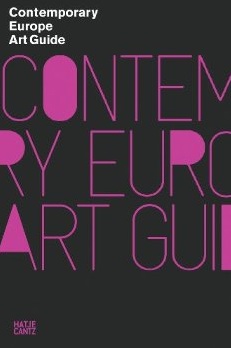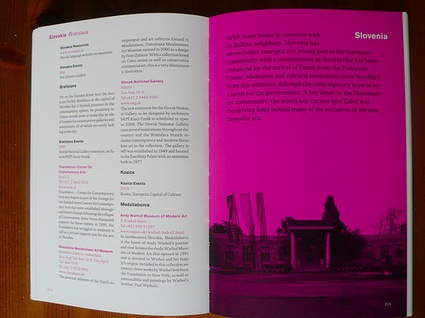 Contemporary Europe: Art Guide to Europe (amazon USA and UK)
Contemporary Europe: Art Guide to Europe (amazon USA and UK)
Publisher Hatje Cantz says: Contemporary Europe Art Guide (…) offers the reader a concise, up-to-date- and insightful presentation of European museums, art institutions, galleries, art fairs, biennials, and works of art in public space. It focuses on giving both the knowledgeable insider and the casual novice a brief and easy-to-use synopsis of European art highlights that are musts on the itinerary of anyone interested in contemporary art.
The Guide was written by Mark Gordon, an art professional living in Berlin and Amsterdam where he manages art projects and writes about contemporary art and architecture.
As its title says, Contemporary Europe Art Guide is a guide, not an essay about contemporary art in Europe. There’s a drastically short introduction to the book and a series of chapters that review each European country one by one and in alphabetical order. “Europe” is defined as the territory bordered by the Atlantic Ocean (W), the Mediterranean Sea (S), the Turkish Stae (SE) and the Russian State (E), not the European Union.
Half a page describes the situation of contemporary art in a given country. That’s a bit of a laconic analysis but a surprisingly accurate one, at least for the dozen of European countries whose art situation i believe i know fairly well. For example (and i’m going to be even more concise than the author of the book here) Italy dedicates so much resources to preservation and restoration that relatively little is left for contemporary art + art institutions are quite often located outside main cities. Or: Arts in Belgium are dominated by the Flemish region but Brussels is raising its head. Meanwhile Wallonia still hasn’t acknowledged that we’ve entered the 21st century a while ago (this last comment comes from me, not from the book!)

After this brief description of a country’s art credentials, comes one page, 40 pages (that’s art-savvy Germany of course) or sometimes zero page that list, city by city, the country’s non-profit art institutions. No independent art dealer then. As far as i can judge, the list does a remarkable job, apart from a few art spaces that i’m sure will be there in the next edition of the guide. The art institutions are listed in a very succinct way: there’s their name, addresses (online and physical one) plus a description of the center focus and activities.
The volume ends with some pretty convenient chapters such as calendars of museums and galleries open days, bienniales and other special exhibitions, prizes, lists of art magazines, art schools and, oh joy!, contemporary art bookstores.
Whether you travel through a country you think you know fairly well or whether you venture into a city where you’ve never been, the guide is a useful companion. Not the kind of companion that is going to entertain you in the plane and hold your luggage while you take the stairs to get out of the metro. It’s just an efficient, polite, handy book. You won’t want to take it in the suitcase but you’ll be glad to have it around while you’re home preparing your trip. I wish i had it already the first time i went to Porto, Krakow and other cities whose airport i don’t know by heart already.
